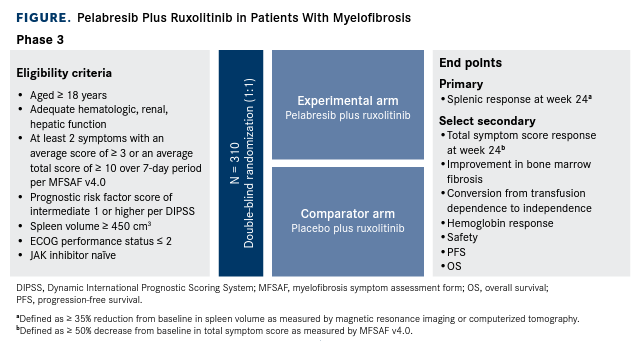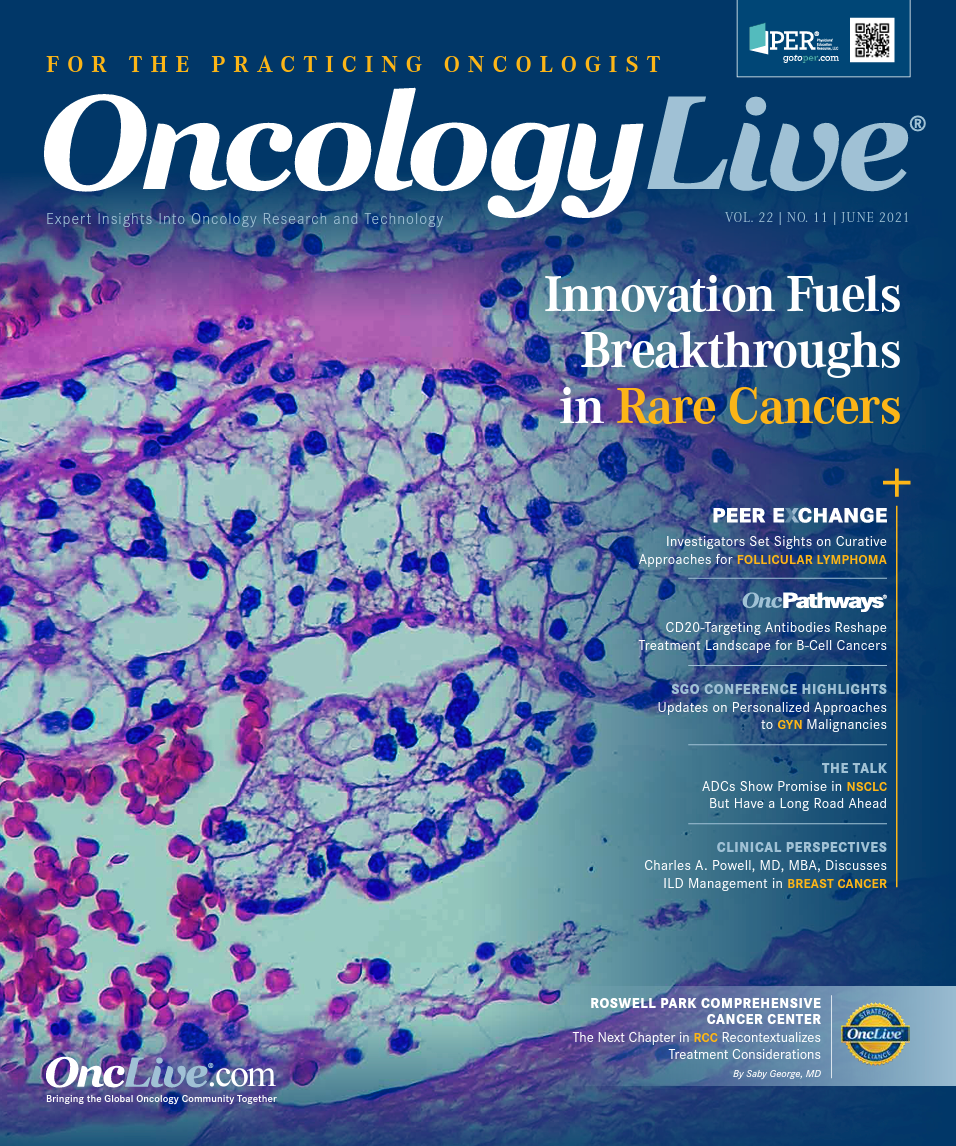Publication
Article
Novel Combination Holds Potential to Address All Hallmarks of Myelofibrosis
Author(s):
In an effort to build on the efficacy demonstrated with ruxolitinib, investigators are evaluating combination therapies—specifically the dual inhibition of the JAK-STAT and BET pathways using pelabresib, a novel BET inhibitor.
Srdan Verstovsek, MD, PhD

The cornerstone of treatment for patients with advanced myelofibrosis is inhibition of the JAK pathway, using agents such as ruxolitinib (Jakafi). In an effort to build on the efficacy demonstrated with ruxolitinib, investigators are evaluating combination therapies—specifically the dual inhibition of the JAK-STAT and BET pathways using pelabresib (formerly known as CPI-0610), a novel BET inhibitor, in the phase 3 MANIFEST-2 trial (NCT04603495).
An orally administered small molecule, pelabresib inhibits the function of BET proteins, which are overexpressed in cancer. BET is a family of epigenetic proteins that may activate oncogene transcription.1
“We’ve always known epigenetic modifiers to be active drugs, but they were limited by myelosuppression, GI [gastrointestinal] toxicities, and other adverse effects,” Srdan Verstovsek, MD, PhD, said in an interview with OncologyLive®. Verstovsek is the United Energy Resources, Inc professor of medicine and director of the Hanns A. Pielenz Clinical Research Center for Myeloproliferative Neoplasms at The University of Texas MD Anderson Cancer Center in Houston.
Research findings have indicated that BET inhibitors are promising in combination with other therapies and can overcome resistance to targeted therapies.2 Specifically, the combination of BET and JAK inhibitors has shown efficacy in preclinical humanized mouse models and may be a therapeutic strategy for myelofibrosis.3 This disease-modifying approach for patients with myelofibrosis is one that investigators hypothesize will affect the disease’s 4 hallmarks: spleen volume, constitutional symptoms, bone marrow f ibrosis, and anemia.4
Findings from 2 clinical trials (NCT00952289 and NCT00934544) that supported the approval of ruxolitinib demonstrated that, compared with placebo, the treatment reduced spleen volume and improved the total symptom score.5 “JAK inhibitors such as ruxolitinib don’t do anything for the anemia that patients with myelofibrosis have,” Verstovsek said. “[In fact,] they can worsen the anemia.”
If approved, pelabresib plus ruxolitinib would change the standard of care for these patients addressing an unmet need to control this treatment-emergent adverse effect (TEAE), he added. “Anemia is a problem that significantly contributes to difficulties in the management [of this disease] because it can be enhanced by ruxolitinib. If you have a combination that can interrupt the anemia, enhance the spleen, and address symptoms, the [treatment of patients] would be very much improved, particularly in those who [have] more advanced [disease] and anemia.”
Initial Safety and Efficacy Data of Pelabresib
Investigators initially examined the efficacy of the dual inhibition strategy for patients with myelofibrosis in the open-label phase 2 MANIFEST trial (NCT02158858). Three experimental arms were established to examine pelabresib: as monotherapy for patients who are refractory, intolerant, ineligible, or no longer receiving ruxolitinib (arm 1); as an additional therapy for patients being treated with ruxolitinib who are not adequately controlled (arm 2); and as a first-line treatment in combination with ruxolitinib for patients who have not received prior treatment with a JAK inhibitor (arm 3).
“[Results from the] ongoing MANIFEST study of CPI-0610 in different clinical settings in patients with myelofibrosis show that you can deliver [pelabresib] in a safe way and see an enhanced benefit that is durable,” Verstovsek said. “The most exciting part is the combination of CPI-0610 and ruxolitinib from the very beginning of treatment. Preliminary results suggest that the combination [of pelabresib and ruxolitinib] has a much better response in the spleen and [reduction of] symptoms vs what you otherwise would expect from ruxolitinib alone.” The preliminary analysis were presented at the 2020 American Society of Hematology Annual Meeting.4,6 The primary end point was 35% spleen volume reduction of at least 35% (SVR35 response) for all patients in arm 3, as well as those who were not transfusion dependent in arms 1 and 2. Benchmark SVR35 response data after 24 weeks of therapy with ruxolitinib from COMFORT-I (NCT00952289), COMFORT-II (NCT00934544), and Simplify 1 (NCT01969838) were used to evaluate the efficacy of pelabresib; SVR35 responses were 41.9%, 32%, and 29%, respectively.4
In arm 1, of the patients who received pelabresib as a monotherapy, 7 of 23 (30%) evaluable patients who were not transfusion dependent at baseline achieved reduction in spleen volume at 24 weeks. Additionally, 10 of 21 (48%) evaluable non–transfusion dependent patients achieved reduction in total symptom scores. Among those who were transfusion-dependent, 3 of 14 (21%) patients converted to transfusion independence.
Of the evaluable non–transfusion-dependent patients from arm 2 who received pelabresib in addition to ruxolitinib, 6 of 21 (29%) patients achieved reduction in spleen volume at 24 weeks and 8 of 21 (38%) achieved reduction in total symptom scores.
Findings from arm 3 included 63 evaluable patients and the SVR35 response was 67% (95% CI, 54%-78%) at 24 weeks. The median spleen volume reduction was 50%. Additionally, 34 of 60 evaluable patients (57%) achieved a reduction in total symptom scores of at least 50% (95% CI, 43%-69%). The median total symptom score reduction was 59%.
In terms of safety, pelabresib was well-tolerated both as a monotherapy and combined with ruxolitinib. The most common grade 3/4 TEAEs for pelabresib monotherapy in 46 safety-evaluable patients in arm 1 were thrombocytopenia (15%), anemia (13%), hyperuricemia (9%), hyperkalemia (6%), dyspnea (6%), diarrhea (4%), constipation (2%), respiratory tract infection (2%), and decreased weight (2%). Nine patients discontinued treatment because of TEAEs.
In arm 2, the most common grade 3 TEAEs in 78 safety-evaluable patients were thrombocytopenia (23%), anemia (10%), respiratory tract infections (5%), diarrhea (4%), asthenic conditions (4%), and nausea (3%). Grade 4 TEAEs included thrombocytopenia (3%) and anemia (1%). Nine patients discontinued treatment due to TEAEs, 6 of whom experienced grade 5 TEAEs.
In the 78 safety-evaluable patients in arm 3 the most common grade 3 TEAEs were anemia (28%) and thrombocytopenia (5%). Grade 4 TEAEs included thrombocytopenia (3%), anemia (1%), and respiratory tract infection (1%). Two patients discontinued treatment due to TEAEs and an additional 2 grade 5 TEAEs of multi-organ failure due to sepsis were reported.
Additionally, 38 of 116 (33%) patients with evaluable samples across all 3 treatment arms had a 1 grade or greater improvement in bone marrow fibrosis. In 32 of 38 (84%) patients, improvements occurred within 6 months of treatment. Only 7 of 116 patients had worsening in bone marrow fibrosis.
In samples from patients in arm 3, 16 of 48 evaluable patients (33%) had at least 1 grade improvement in bone marrow fibrosis; in 14 of 16 (88%) patients, improvements occurred within 6 months of starting treatment. Only 2 of 48 patients had worsening in bone marrow fibrosis.
Analysis of patient samples from MANIFEST suggest that pelabresib promotes normalization of megakaryocyte and erythroid differentiation and proliferation. Researchers from Constellation Pharmaceuticals, pelabresib’s developer, believe this may be why the agent improves bone marrow function and hemoglobin levels.4
FIGURE. Pelabresib Plus Ruxolitinib in Patients With Myelofibrosis

Details of the MANIFEST-2 Trial
MANIFEST-2 is a randomized, double-blind phase 3 trial to study pelabresib in combination with ruxolitinib compared with ruxolitinib alone (FIGURE). Investigators plan to enroll 310 adult patients with advanced myelofibrosis who have not been previously treated with a JAK inhibitor across 10 sites in the United States and Canada.
Patients must have at least 2 symptoms with an average score of at least 3 or average total score of at least 10 over a 7-day period using the myelofibrosis symptom assessment form version 4.0, as well as spleen volume of at least 450 cm3. Enrolled individuals will be stratified by Dynamic International Prognostic Scoring System category (intermediate 1 vs intermediate 2 vs high), platelet count (> 200 × 109/L vs 100 to 200 × 109/L), and spleen volume (≥ 1800 cm3 vs < 1800 cm3).
Investigators will administer pelabresib or the placebo in 3-week cycles comprising 2 weeks of treatment and a 1-week break. Verstovsek noted that ruxolitinib will be administered in a dose-escalated manner. “There is a possibility that CPI-610 may lower platelet counts. That is 1 reason why the drug is given 2 weeks on and 1 week off,” Verstovsek said. “The design also asks for ruxolitinib to be under dosed in the beginning, the so-called level minus 1, for safety reasons. After 1 month, patients will have the dose of ruxolitinib increased to the standard starting dose.”
The study’s primary end point is SVR35 response at 24 weeks and a key secondary end point is 50% or greater improvement in total symptom score from baseline at 24 weeks.
Other secondary end points include improvement in bone marrow fibrosis, conversion from transfusion dependence to independence, duration of splenic and total symptom score response, hemoglobin response, safety, progression-free survival, and overall survival.
References
- Shorstova T, Foukles WD, Witcher M. Achieving clinical success with BET inhibitors as anti-cancer agents. Br J Cancer. 2021(124):1478-1490. doi:10.1038/s41416-021-01321-0
- Doroshow DB, Eder JP, LoRusso PM. BET inhibitors: a novel epigenetic approach. Ann Oncol. 2017;28 (8):1776-1887. doi:10.1093/annonc/mdx157
- Jiang Q, Jamieson C. BET’ing on dual JAK/BET inhibition as a therapeutic strategy for myeloproliferative neoplasms. Cancer Cell. 2018;33(1):3-5. doi:10.1016/j.ccell.2017.12.007
- CPI-0610: update of preliminary data from MANIFEST. Constellation Pharmaceuticals. December 7, 2020. Accessed May 11, 2021. https://ir.constellationpharma.com/staticf iles/38499703-7211-4e12-82ef-ff6e1f863172
- Jakafi. Prescribing information. Incyte Corp. Revised January 2020. Accessed May 3, 2021. https://www.jakafi.com/pdf/ prescribing-information.pdf
- Constellation Pharmaceuticals provides update of MANIFEST study for CPI-0610 at ASH meeting. News release. Constellation Pharmaceuticals. December 6, 2020. Accessed May 3, 2021. https://ir.constellationpharma.com/news-releases/news-release-details/constellation-pharmaceuticals-provides-update-manifest-study-cpi









